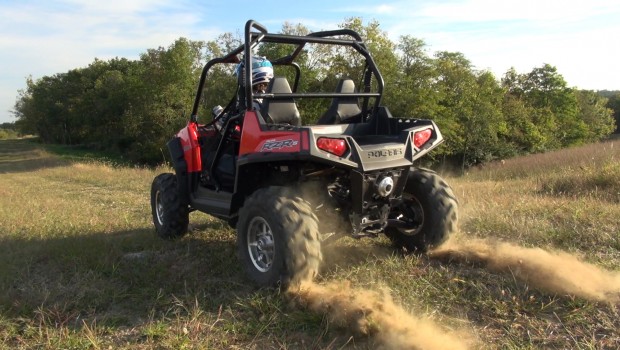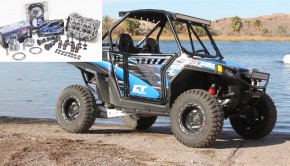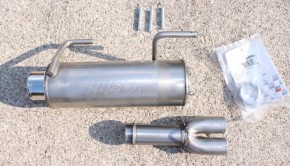RZR 800 HMF Swamp Series Exhaust and Optimizer Test: with VIDEO
HMF’s sleeper system enhances appearance, boosts power, and keeps noise low.
 Since launching the pure sport side-by-side segment with the RZR 800, a lot of side-by-side enthusiasts have purchased vehicles powered by Polaris’ 760cc, parallel twin-cylinder engine.This power plant is used in the 50-inch wide 800 since its release. It’s also used in the RZR S and RZR 800 XC Edition.
Since launching the pure sport side-by-side segment with the RZR 800, a lot of side-by-side enthusiasts have purchased vehicles powered by Polaris’ 760cc, parallel twin-cylinder engine.This power plant is used in the 50-inch wide 800 since its release. It’s also used in the RZR S and RZR 800 XC Edition.
A good performance exhaust system is the first modification most enthusiasts turn to when looking to enhance their machine’s performance. With so many of these engines out there and a RZR S in our position, we acquired an HMF Swamp Series exhaust and HMF Fuel Optimizer programmer to find out what 800 owners can expect from this common upgrade.
The Exhaust
HMF’s exhausts are made in the USA. They currently offer two systems for the RZR 800s, the Swamp, and Swamp XL series. Both series are available as a full system only for the RZR 800s, complete with new head pipe and silencer. Keep in mind that different RZR 800 models require small variations in exhaust design, so one size does not fit all, although the results should be virtually identical on any Polaris High Output 800.

The Swamp series is the quieter of the two systems. HMF claims that it keeps sound levels within one to two decibels of stock while the Swamp XL is claimed to put out a bit more power than the Swamp series. HMF makes no bones about it–– the XL system is unrestricted and extra loud.
The Swamp series is the quieter of the two systems. HMF claims that it keeps sound levels within one to two decibels of stock while the Swamp XL is claimed to put out a bit more power than the Swamp series. HMF makes no bones about it–– the XL system is unrestricted and extra loud. We gave HMF the option of choosing which system we tried. Understanding the importance of keeping sound levels low on public lands and for your neighbors, they opted to send us the quieter Swamp Series.
Other than a slightly different core in the Swamp series to control sound output, both systems feature nearly identical design. They’re constructed primarily of 304 stainless steel. The silencer features a 5-inch shell providing more internal volume, which is claimed to boost horsepower.The silencer’s intake is tig-welded shut providing a water-tight exhaust when used with HMF’s accessory snorkel.
We spent a little over an hour installing the exhaust. Most of the time was spent removing the bed of the machine to get a better look at the situation. The HMF exhaust bolted right up with perfect fitment.
Fuel Optimizer
HMF’s Fuel Optimizer comes pre-programmed with a map designed to work with HMF exhausts. The Optimizer features on-board, 16-way fuel adjustment settings that can be individually tuned for low, mid, and upper RPM ranges. This feature makes the Optimizer very easy and convenient for trail or trackside tuning, without the need or understanding of how to program your controller with a laptop computer.
The Optimizer’s on-board programming is a little limited. There is enough adjustment to adapt the fuel injection for the exhaust, air filters, and some other external bolt-ons, but radical changes in fuel to compensate for high-compression pistons and big bore kits may require you to send your programmer in to HMF to have the programmer’s base line mapping altered. If you aren’t planning on building a full-on race motor, the on-board programming is all you’ll need.

makes the Optimizer very easy and convenient for trail or trackside tuning, without the need or understanding of how to program your controller with a laptop computer.
The Optimizer is easy to install. Ground it to the negative battery terminal, plug it into the wiring harness located under the panel behind the seats, and you’re ready to go.The installation instructions made the process more confusing than it needed to be.
The Test
Firing up the RZR S for the first time with HMF’s exhaust, we were taken back by how similar it sounded to stock. Perhaps it’s a bit throatier, but without hearing two machines side-by-side, we can’t say for sure if it’s any louder than stock. It sounds good, but is no more offensive than stock for neighbors or occupants.
When the RZR 800 was introduced, it ripped compared to other machines on the market, due to its combination of light weight and good horsepower. The engine isn’t a particularly fast revver, though, due to its dated engine design. The addition of the HMF Swamp Series exhaust to the Fuel Optimizer doesn’t transform this into a smaller version of the super-fast revving Pro Star engines used in the RZR 900 and 1000, but they do definitely enhance performance.

There is no big, notable increase at any one area of the RPM range, but the engine feels less taxed driving hard out of tight turns, drifting corners, and pulling steep hills.
HMF claims that they designed the exhaust to boost horsepower across the RPM range and we believe it.There is no big, notable increase at any one area of the RPM range, but the engine feels less taxed driving hard out of tight turns, drifting corners, and pulling steep hills.
Although there was plenty of power to get the rear tires spinning on hole shots, the smooth engagement of Polaris’ CVT transmission made judging low-end power difficult; however, midrange and top-end were improved.A good aftermarket clutch will help you get more out of your RZR 800 and the HMF exhaust when you stomp the pedal.
Nothing showed the difference between the stock and HMF-equipped RZR as well as the stopwatch. We repeatedly ran a long, mildly whooped-out hill climb, which ramped up to a 45-degree angle for about 40 feet just before the top. The trail was minimally demanding of the driver, but kept the engine under a continuous, but varying, load.
Aaron Meyer performed three runs with the stock exhaust, then three runs with the HMF exhaust and Fuel Optimizer installed.His three runs with the stock exhaust averaged out to 13:44 seconds. With the HMF Swamp Series exhaust and Fuel Optimizer installed, the average time dropped 0.9 seconds to 12:54 seconds, clearly outperforming the stock RZR on the hill.
The Verdict
The combination of the HMF Swamp Series Exhaust delivers an increase in horsepower and torque that will let you pull hills, churn through mud, or add more power to compensate for the additional weight of bolt-on accessories. So far, build quality seems very good and fitment is excellent.
If you want to feel more snap when you mash the gas, a different clutch kit is mandatory, but our stopwatch proved that the RZR 800 will run stronger with HMF’s Swamp Series exhaust and Fuel Optimizer.
Manufacturer: HMF
Products
HMF Swamp Series Exhaust: $769.95
HMF Fuel Optimizer: $329.95
Hill Drag Results
Stock Times
Run 1: 13.18 sec
Run 2: 13.55 sec
Run 3: 13.6 sec
Average: 13.44 sec
With HMF Swamp Series Exhaust and Fuel Optimizer
Run 1: 12.7 sec
Run 2: 12.54 sec
Run 3: 12.38 sec
Average: 12.54 sec
Difference: 1.1 sec
RZR 800 HMF Swamp Series Exhaust and Optimizer
Summary: The combination of the HMF Swamp Series Exhaust delivers an increase in horsepower and torque that will let you pull hills, churn through mud, or add more power to compensate for the additional weight of bolt-on accessories. So far, build quality seems very good and fitment is excellent. If you want to feel more snap when you mash the gas, a different clutch kit is mandatory, but our stopwatch proved that the RZR 800 will run stronger with HMF’s Swamp Series exhaust and Fuel Optimizer.











